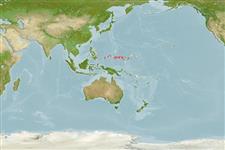Klassifizierung / Names
Namen | Synonyme | Catalog of Fishes(Gattung, Arten) | ITIS | CoL | WoRMS | Cloffa
>
Ovalentaria/misc (Various families in series Ovalentaria) >
Pomacentridae (Damselfishes) > Chrominae
Etymology: Chromis: Greek, chromis = a fish, perhaps a perch (Ref. 45335); degruyi: Named for Michael V. DeGruy..
Environment: milieu / climate zone / depth range / distribution range
Ökologie
seewasser riff-verbunden; tiefenbereich 81 - 120 m (Ref. 59379). Tropical
Western Pacific: Palau.
Size / Gewicht / Alter
Maturity: Lm ? range ? - ? cm
Max length : 8.2 cm SL Männchen/unbestimmt; (Ref. 59379)
Rückenflossenstacheln (insgesamt): 13 - 14; Rückenflossenweichstrahlen (insgesamt): 11-12; Afterflossenstacheln 2; Afterflossenweichstrahlen: 11 - 12. This species is distinguished by the following: Dorsal rays XIII-XIV, 11-12, usually XIV, 12; anal rays II, 11-12, usually 12; pectoral rays 18; spiniform caudal rays 3; tubed lateral-line scales 15-17; gill rakers 7 + 20-21 (total 27-28); body depth 1.84-1.99 in SL. Color of the adults when fresh is dull brownish yellow with nine thin lavender-gray stripes on the side of body; a prominent black spot on dorsal half of pectoral-fin base (Ref. 59379).
Adults inhabit deep outer-reef slopes at depths of 85-120 m, usually in the vicinity of rock outcrops with small holes and caves, and around limestone talus; usually found in small groups and observed feeding low in the water column (Ref. 59379). Oviparous, distinct pairing during breeding (Ref. 205). Eggs are demersal and adhere to the substrate (Ref. 205). Males guard and aerate the eggs (Ref. 205). Minimum depth reported taken from Ref. 128797.
Life cycle and mating behavior
Geschlechtsreife | Fortpflanzung | Ablaichen | Eier | Fecundity | Larven
Oviparous, distinct pairing during breeding (Ref. 205). Eggs are demersal and adhere to the substrate (Ref. 205). Males guard and aerate the eggs (Ref. 205).
Pyle, R., J.L. Earle and B.D. Greene, 2008. Five new species of the damselfish genus Chromis (Perciformes: Labroidei: Pomacentridae) from deep coral reefs in the tropical western Pacific. Zootaxa 1671:3-31. (Ref. 59379)
IUCN Rote Liste Status (Ref. 130435)
Bedrohung für Menschen
Harmless
Nutzung durch Menschen
Mehr Information
Alter/GrößeWachstumLänge-GewichtLänge-LängeLängenhäufigkeitenMorphometrieMorphologieLarvenLarven Pop.Dyn.RekrutierungDichteBRUVS
ReferenzenAquakulturAquakultur ProfilZuchtlinienGenetikElectrophoresesVererbbarkeitKrankheitenVerarbeitungNutrientsMass conversion
PartnerBilderStamps, Coins Misc.LauteCiguateraGeschwindigkeitSchwimmstilKiemenoberflächeOtolithsGehirngrößeSehfähigkeit
Tools
Zusatzinformationen
Download XML
Internet Quellen
Estimates based on models
Preferred temperature (Ref.
123201): 12.8 - 27.4, mean 25.2 °C (based on 5 cells).
Phylogenetic diversity index (Ref.
82804): PD
50 = 0.5000 [Uniqueness, from 0.5 = low to 2.0 = high].
Bayesian length-weight: a=0.01778 (0.00796 - 0.03971), b=2.99 (2.81 - 3.17), in cm total length, based on LWR estimates for this Genus-body shape (Ref.
93245).
Trophic level (Ref.
69278): 3.0 ±0.1 se; based on size and trophs of closest relatives
Widerstandsfähigkeit (Ref.
120179): hoch, Verdopplung der Population dauert weniger als 15 Monate. (Preliminary K or Fecundity.).
Fishing Vulnerability (Ref.
59153): Low vulnerability (10 of 100).
